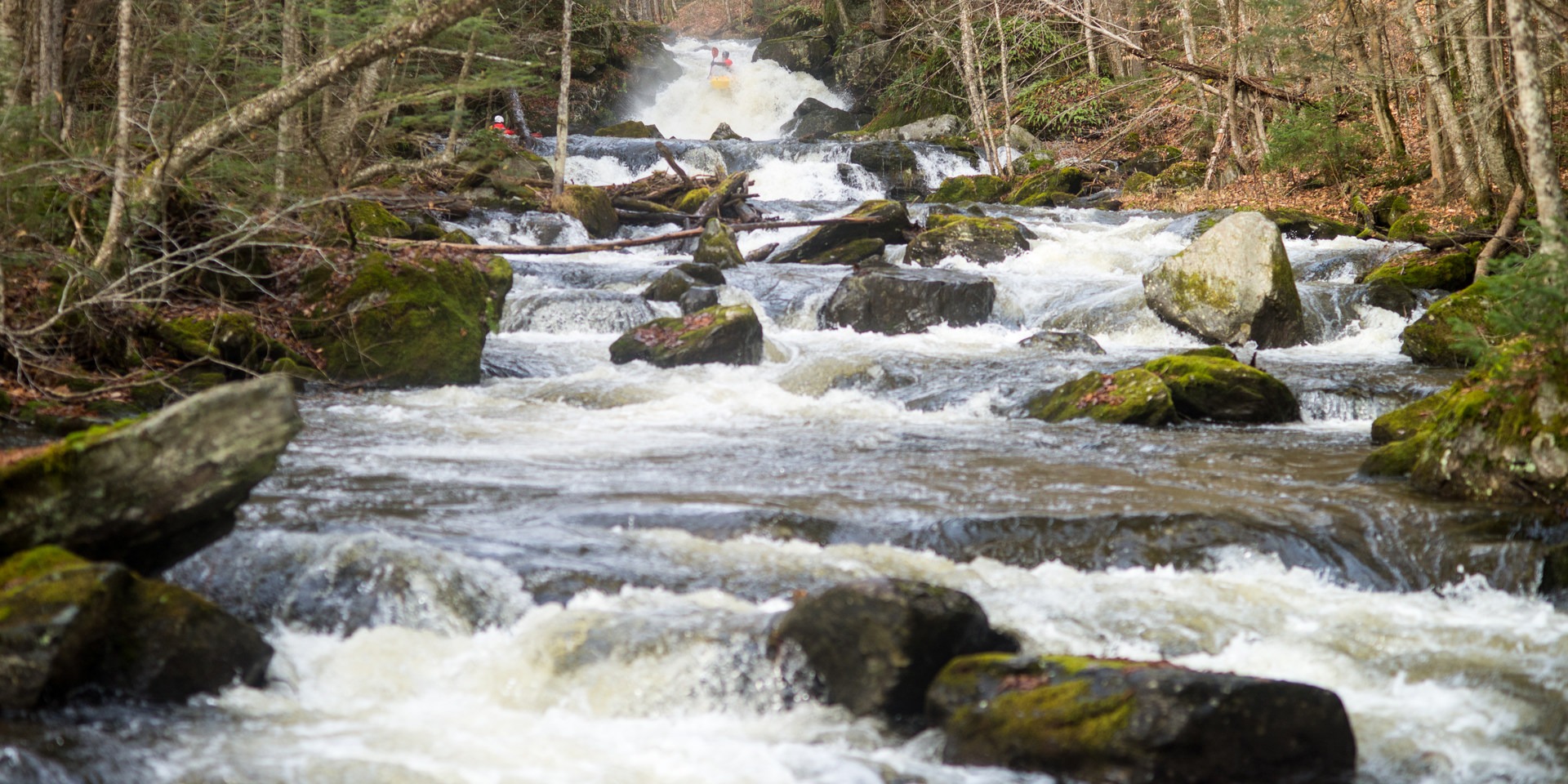You are here
Vermont's Green River gained popularity largely due to the efforts of Ryan McCall and Dave Packie. In October, 2012, American Whitewater conducted a Flow Study with Morrisville Water and Light to determine the recreational value of the Lower Green River at various flows. Nearly 30 paddlers showed up to explore and show their support and encourage access.
Since then, the dam operators at MWL have alerted local paddlers whenever they expect to release a full tube or more. The flow study determined one full tube is the minimum enjoyable flow, and it equates to about 2.3 feet on the stick gauge on the Route 15 Bridge. The quality (and difficulty) of the rapids increases with higher water, all the way up to a full two tube release.
Put in below the massive cascade under the Garfield Road Bridge by scrambling down the steep slope next to the pull off. This Class VI waterfall has been run, resulting in a serious back injury.
Just below the put-in the river splits, with the right side going down a junky Class IV sneak called Plop Plop Fizz while the left drops about 12 feet over a Class V ledge falls called Moonshine. Plop Plop Fizz is arguably more difficult than Moonshine, but it is less consequential. Scout from the right, and try to keep your bow up. Moonshine requires a precise boof, turning right as you fall to avoid a piton and/or pin. The lead in is tricky, and there are a few rocks exactly where you wouldn't want them. Scout from the left.
Immediately below this point the river reconvenes just above a 3-foot ledge that continues to a Class III rapid toward a sweeping left turn. The chute here has an undercut boulder on the right, but it's easily avoided if you know it's there.
Plenty of Class II and Class III water follows for the next quarter-mile before flattening out. There are often logs down in this stretch, but many of them can be avoided. If you're in doubt, they are easy to portage because the current is slow in this flat and wide section of the river valley.
At mile 1.2 the river makes a slight turn to the right and narrows significantly. Takeout on either side well above the horizon to scout or portage Young Buck, a Class V mini-gorge with hidden hazards.
In addition to the visible log near the exit of the gorge there is another one on river left in the outflow, and there are several potholes throughout the gorge. Swimming here is not an option.
Shortly downstream a Class III rapid with a large pillow against a boulder in the center of the river should be run on the left.
At mile 1.5 the river again narrows with a horizon line. This is Humble Pie, Class V-, and one of the best rapids on the river. Get out well above the horizon and scout from either side. The Class III lead in adds to the difficulty of the rolling lip on this 10-foot waterfall. The hole at the bottom can be quite sticky, especially at higher flows. Even good local paddlers have found themselves swimming out into the short pool after getting thrashed, hence the name.
Below Humble Pie is a ledge that should be boofed with a left angle to avoid a sharp flake that is notorious for cracking boats. Eddies abound, but the river picks up gradient for about a quarter-mile, crashing down Class III+ ledges. At a sharp turn to the left, paddlers will want to drive from right to left down a surprise Class IV- slide.
The river flattens out and passes below an old bridge. Around the next corner is Lumberyard, Class IV, so named for it's affinity for collecting wood. Scout on the left. With appropriate water levels, the center boof is quite fun. Running just to the left of it with a slight right angle is also a common line. Just downstream, a double set of ledges is best run on the left. More class III rapids follow.
At mile 2.5, a long rapid flows into a Class IV slide that can be run anywhere near the center. A short moving pool leads into the Piton Rapid, Class IV, which can be banged down the left or center or boofed with a hard right angle on the extreme river right side. The piton sits right of center, and it catches many unwary paddlers.
Class II and III water leads to the confluence with the Lamoille, where paddlers will likely need to paddle downstream for a mile to the Lamoille Fishing Access along Route 15. Consult local paddlers for additional take out options.
Shuttle
From the takeout, follow Route 15 west until you reach Garfield Road on your right. Follow Garfield Road to the intersection of Carpenter Hill Road and turn right over the bridge near the put in. Take your immediate right, and head into the pullout at the put-in.
Logistics + Planning
Current Weather: Powered by Dark Sky






























Comments
Sign In and share them.